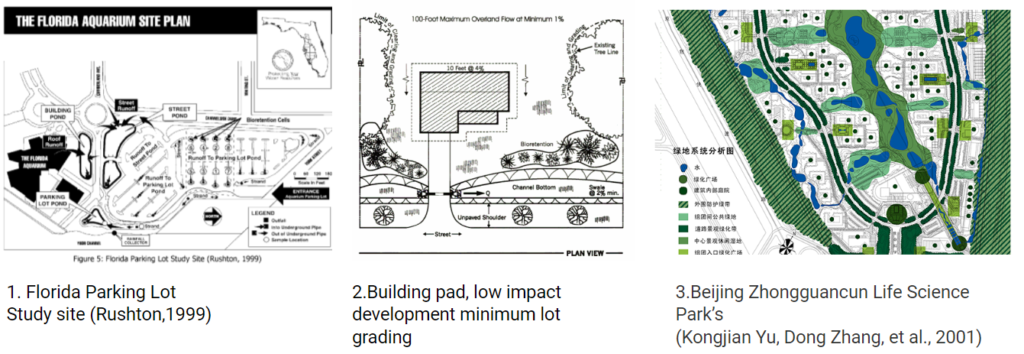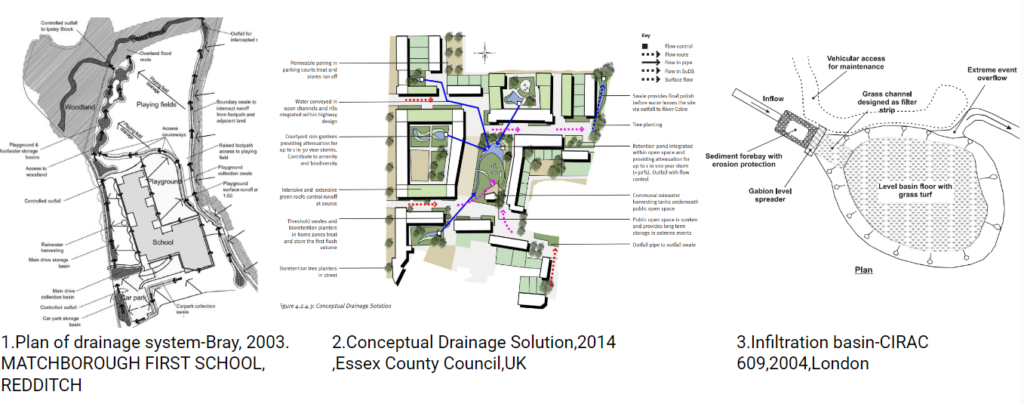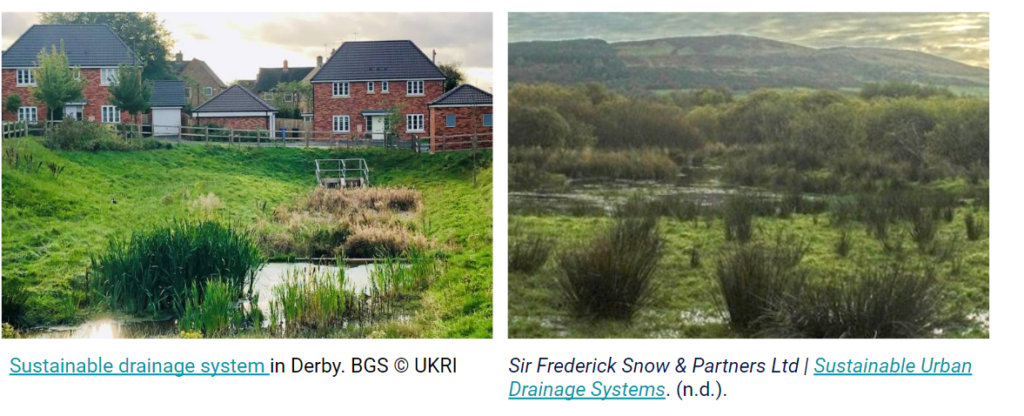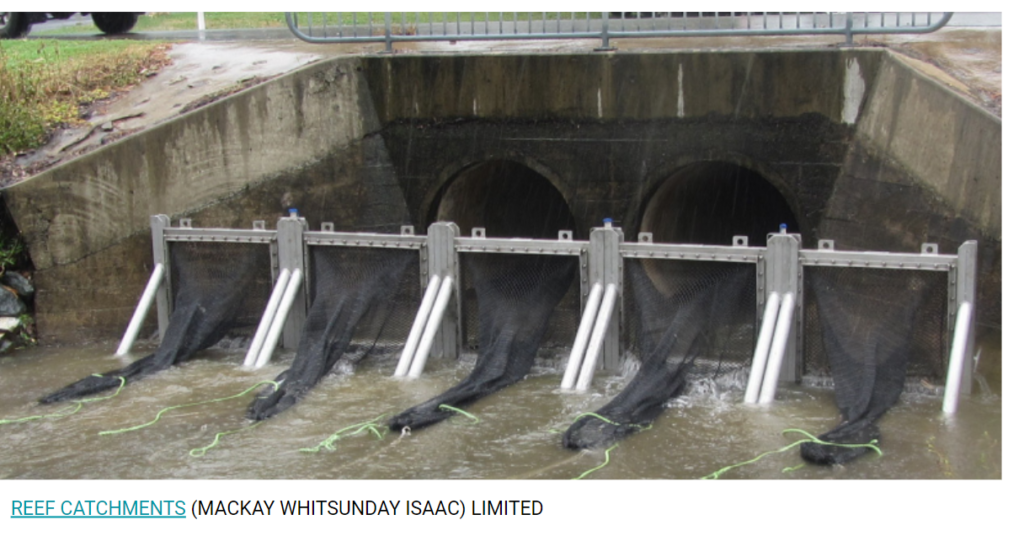There are different implementations around the world for Urban drainage systems that had been evolving throughout the time, implemented with different solutions responding to the conditions of the place from informational, topographical to climatological. Developing codes and norms for its correct implementation.
LID-Low impact development.
Used in North America and New Zealand.
Combines a hydrologically functional site design with pollution prevention measures to compensate for land development impacts on hydrology and water quality, the primary goal is to mimic the predevelopment site hydrology by using site design techniques that store, infiltrate, evaporate, and detain runoff.Comprehensive technology-based approach to managing urban stormwater managed in small cost effective landscape LID design can also significantly reduce development costs through side design by reducing impervious surfaces

Stormwater control measures (SCMs)
First used in North America United States.
Stormwater Control Measures (SCMs) are designed to remove pollutants from urban runoff, improve water quality and control quantity before the water reaches our streams and drinking water supply reservoirs. Stormwater SCMs offer both “non-structural” and “structural” approaches to water quality protection. Non-structural measures include such practices as minimizing impervious area for site development, providing vegetative buffers along all streams and waterways, promoting natural infiltration of runoff, pollution prevention practices such as regular sweeping of parking lots and public environmental outreach programs. Structural SCMs are permanent devices, which are designed, constructed and maintained to remove pollutants from runoff. While it is important to note that structural SCMs are only one part of a comprehensive watershed management plan, they play a critical role in protecting water quality in our receiving streams and lakes by removing or filtering out pollutants in runoff. Without these constructed devices, pollutants in urban runoff would directly enter the closest stream or lake, possibly impair downstream water quality or aquatic life and also degrade the quality of our drinking water reservoirs. Many different kinds of SCMs can be installed, such as stormwater wetlands, bioretention cells, infiltration basins, dry detention areas or wet detention ponds. As BMPs were installed, it was recognized that much of what was constructed was clearly not ‘best practice’ and the term BMP was far too vague. Partially in response to the lack of an objective approach to stormwater management, the US National Research Council of the National Academies of Engineering and Science commissioned a comprehensive review of stormwater management practice. One key element of the term is that it does not convey a judgment as to whether a selected practice functions ‘best’. Since the release of the 2008 NRC report, many entities have adopted the term SCM, including the US Federal Highway Administration, many state departments of transportation, academic publications and several “higher end” consultancies. The choice of plant species and filter materials for bioretention substitution of boutique media for the gravel base course of permeable pavement , the creation of predictive models for practices such as swales and real-time controlled discharge of water from rainwater harvesting systems.

Water sensitive urban design (WSUD).
WSUD,Australia-1990 first mentioned by Mouritz & later by Western Australian Government by Whelans 1994
WSUD as a “philosophical approach to urban planning and design that aims to minimize the hydrological impacts of urban development on the surrounding environment. Stormwater management is a subset of WSUD directed at providing flood control, flow management, water quality improvements and opportunities to harvest stormwater to supplement mains water for non-potable uses”. It cites the objectives of WSUD In Australia, the term WSUD is now often used in parallel with the term water sensitive cities. However, there is a subtle but important distinction between these two terms; water sensitive city describes the destination (the objective), while WSUD describes the process. Manage the water balance (considering groundwater and streamflows, along with flood damage and waterway erosion maintain and where possible enhance water quality (including sediment, protection of riparian vegetation, and minimize the export of pollutants to surface and groundwaters), encourage water conservation (minimizing the import of potable water supply, through the harvesting of stormwater and the recycling of wastewater, and reductions in irrigation requirements), and maintain water-related environmental and recreational opportunities”.

Best management practices (BMPs)
North American (primarily the United States and Canada) Originally drafted in 1972.
Best management practice (BMP) is used to describe a type of practice or structured approach to prevent pollution. In the United States, the term BMP was coined – yet never explicitly defined – as part of the Clean Water Act (CWA) (2011), when it was originally drafted in 1972. The definition of BMPs has since matured into a more or less universal term referring to pollution prevention activities, consistent with the Pollution Prevention Act (United States of America, Citation 1990). Accordingly, the term encompasses practices that possess both non-structural (operational or procedural practices; e.g., minimizing use of chemical fertilizers and pesticides) and structural (engineered or built infrastructure) attributes.BMPs may include “….schedules of activities, prohibitions of practices, maintenance procedures… (including) treatment requirements, operating procedures, and practices to control plant site runoff, spillage or leaks, sludge or waste disposal, or drainage from raw material storage” (Environmental Protection Agency, Citation 2011a). In this context of stormwater management, BMPs link non-structural methods (e.g., good housekeeping and preventive maintenance) with structural deployments (such as bioretention systems or green infrastructure) to achieve the overall goal of pollution prevention.

SUDS- Sustainable drainage systems
Sustainable drainage systems (SUDS) are increasingly being used to mitigate the flows and pollution from runoff. The philosophy of SUDS is to replicate as closely as possible the natural drainage from a site before development and to treat runoff to remove pollutants, so reducing the impact on receiving watercourses. This requires a reduction in the rate and volume of runoff from developments, combined with treatment to remove pollutants as close to the source as possible. They can also provide other environmental benefits such as wildlife habitat, improved aesthetics or community resource
UK- 2004

Environmentally Sensitive Area-ESA
Municipal government planning in Ontario,Canada Under the British North America Act of 1867
ESAs are natural landscapes that contain features such as: aquifer recharge, headwaters, unusual plants, wild- life, or landforms, breeding or overwintering animal habitats, vital ecological functions, rare or endangered species, or combinations of habitat and land
The criteria for selecting ESAs for designation in official plans includes, but are not restricted to, any one or combination of the following:
- The area represents a distinctive and unusual landform within the municipality, Ontario or Canada.
- The ecological function of the area is vital to the healthy maintenance of a natural system beyond its boundaries, such as, serving as a water storage or recharge area, important wildlife migratory stopover or concentration point, or a linkage of suitable habitat between natural biological communities.
- The plant and/or animal communities of the area are identified as unusual or of high quality locally within the municipality, Ontario or Canada.
- The area is an unusual habitat with limited representation in the municipality, Ontario or Canada, or a small remnant of particular habitats which have virtually disappeared within the municipality.
- The area has an unusually high diversity of biological communities and associated plants and animals due to a variety of geomorphological features, soils, water, sunlight and associated vegetation and microclimatic effects.
- The area provides habitat for rare or endangered indigenous species that are endangered regionally, provincially, or nationally.
- The area is large, potentially affording a habitat for species that require extensive blocks of suitable habitat.
- The location of the area, combined with its natural features, make it particularly suitable for scientific research and conservation education purposes.
- The combination of landforms and habitats is identified as having high aesthetic value in the context of the surrounding landscape and any alteration would significantly lower its amenity value.

Alternative techniques (ATs) or compensatory techniques (CTs)
Began in France on the early 1980’s promoted to solve drainage and pollution problems as well as quality of life
The term alternative techniques (ATs) or techniques alternatives (TAs) in French, began to be used in the early 1980s in French speaking countries to describe a new paradigm of urban drainage (STU, Citation 1981, Citation 1982), moving away from the traditional ‘rapid disposal’ approach. The expansion of towns and suburbs, particularly in Paris, along with the costs of reinforcing or constructing traditional networks (IAURIF,Citation 1981) and a concern about environmental impacts, created a push for more natural solutions, termed ATs. They were promoted not only to solve drainage and pollution problems, but also for their potential to improve quality of life. One of the first French guidelines was called “Stormwater runoff control: solutions to improve the quality of life” (STU, Citation 1982). The term ‘alternative’ was meant in the sense of ‘unconventional’, and somewhat even in the sense of ‘against’ conservative solutions. Alternative techniques aimed to counteract the effect of urban expansion by optimising urban land use and / limiting investment costs. They were thus also called compensatory techniques, since they were considered to compensate for the impacts of urbanisation.

Green Infrastructure-GI
Emerged in USA in 1990 by Anthony Walmsley
The term green infrastructure (GI) emerged in the USA in the 1990s (e.g. Walmsley, Citation 1995) The GI concept influences urban planning and layouts to maximize the inclusion of green space hubs and corridors, but the GI process also attempts to maximize the benefits of such green spaces, identifying their potential ecosystem services (Center for Neighborhood Technology, Citation 2010). Among these services, the potential usage of GI to assist stormwater management was realized by the US EPA (Citation 2012) and others and now the term is often used interchangeably with BMPs and LID (Struck et al., Citation 2010).GI is defined variously in the US stormwater management literature as “a network of decentralized stormwater management practices, such as green roofs, trees, rain gardens and permeable pavement, that can capture and infiltrate rain where it falls, thus reducing stormwater runoff and improving the health of surrounding waterways” and is now “more often related to environmental or sustainability goals that cities are trying to achieve through a mix of natural approaches” (Foster et al., Citation 2011). In Seattle, the term GSI (green stormwater infrastructure) is used in design codes which specify its use to the “maximum extent feasible” – which means GI is to be fully implemented, constrained by the opportunities and physical limitations of the site, practical considerations of engineering design, and reasonable consideration of financial costs and environmental impacts (Tackett, Citation 2008).

Stormwater Quality Improvement Devices – SQIDS
Australia first coined by Brisbane city council 1998
One term that received significant local use in Australia was stormwater quality improvement device (SQUID). The term appears to have been first coined by Brisbane City Council in their SQIDS monitoring report (Citation 1998). The term has since been used in the wider literature (Begum & Rasul, Citation 2009; Begum et al., Citation 2008; Van Drie, Citation 2002), although primarily in conference communications, and almost exclusively in relation to Australian studies. Its use has diminished in recent years, in part because of the increasing focus on managing both flow and water quality, meaning that stormwater quality improvement describes only partially the goals of such systems, which typically also target hydrological control. SQIDs are designed to remove a wide range of pollutants including sediments, metals, oils, nutrients, and gross pollutants from stormwater before it has a chance to join any natural bodies of water. SQIDs are used to implement best practice quality management of stormwater ensuring Water Quality Objectives are met as per the local requirements, protecting downstream rivers, creeks, and other water bodies. Most SQIDs have been designed for management of pollutant loads during a developments operational phase. However, some regional or developing areas may require on-site stormwater treatment devices to be utilised during the construction phase as a sediment and litter trap. Because SQIDs are often associated with significant ongoing maintenance and construction costs, alternative strategies such as source controls should always be considered and evaluated carefully.


SPONGE CITY CONCEPT/URBAN SPONGE /GREEN SPONGE SYSTEM/RESILIENT CITY
Groundwork started in 1997 by Doctor Kongjian Yu used the concept of a sponge to describe the flood-control capacity of natural systems
Holistic and natured-based solution to protect and restore ecological infrastructure and make wise use of the planet and the welfare of people. The infrastructure for sponge cities is philosophy is to retain water at its source slow down its flow and be adaptive to at the sink. Retain, adapt, slow down and reuse which involves designing and constructing city-wide systems of ponds, wetlands, and parks that retain stormwater. urban landscapes that are softer and purposely designed to absorb more water. The ‘living sponge’ concept restores urban landscapes as active systems able to soak up excess water that can then be ‘squeezed’ out for reuse. These urban green sponges cleanse and retain water, harvesting rainwater to recharge aquifers, while creating productive landscapes, diverse habitats and multiple social benefits

Flood adaptive
Flood adaptive, able to remediate agricultural runoff and biologically diverse, as well as providing social havens for connection and respite.


